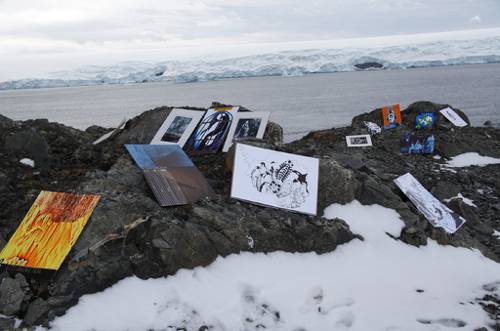
FAQ About The Influence of Eco-Art on Environmental Awareness

What is eco-art?
Eco-art is a form of contemporary art practice that addresses ecological and environmental issues. Artists working in this field often use sustainable materials and methodologies, striving to not only create visually engaging works but also to provoke thought and raise awareness about environmental challenges. Eco-art can take many forms, including installations, sculptures, public art, and performances.

How does eco-art raise environmental awareness?
Eco-art raises environmental awareness by creatively showcasing the impacts of environmental degradation and encouraging the public to engage with ecological issues. By bridging aesthetics with pressing environmental themes, eco-art can inspire viewers to rethink their relationship with nature and consider more sustainable practices. It often involves community participation, making the message more personal and impactful.

Who are some prominent eco-artists?
Some renowned eco-artists include Agnes Denes, known for her projects like 'Wheatfield – A Confrontation' in Manhattan, which juxtaposed nature against urban development, and Andy Goldsworthy, who creates ephemeral works that interact with natural environments. Another key figure is Olafur Eliasson, who addresses climate change through immersive installations, such as 'Ice Watch,' which brought free-floating Greenland icebergs to prominent city centers.

What themes are commonly explored in eco-art?
Eco-art often explores themes such as climate change, biodiversity, conservation, and sustainability. Artists may focus on human impacts on the environment, like pollution and deforestation, or emphasize the beauty and fragility of natural ecosystems. Through their work, they aim to raise questions and provoke contemplation about our interactions with nature and the urgent need for ecological responsibility.

Can eco-art be considered an educational tool?
Yes, eco-art can serve as a powerful educational tool by visually communicating complex environmental issues in an accessible manner. It can complement scientific data by making it more relatable and engaging, thereby enhancing public understanding and interest. Schools and public institutions often use eco-art projects to involve communities and foster environmental education.

How does eco-art contribute to sustainability?
Eco-art contributes to sustainability by utilizing resources mindfully and promoting eco-friendly practices. Artists may use recycled materials, renewable energy sources, and other sustainable practices in their work. Additionally, eco-art often encourages audiences to adopt sustainable behaviors by shedding light on environmental impacts and advocating for conservation efforts.

What materials are commonly used in eco-art?
Materials used in eco-art are often sustainable, recycled, or derived from the local environment. Common materials include reclaimed wood, metal, plastics, natural fibers, and earth materials such as stones and soil. The choice of materials is typically aligned with the artistic message, emphasizing the importance of resourcefulness and mindful consumption.

What role does community engagement play in eco-art?
Community engagement is a central component of many eco-art projects, as it helps to personalize and localize the environmental message. By involving community members in the creation process, eco-art can foster a collective sense of responsibility and empowerment. Participatory projects encourage communities to take action and promote environmental change from a grassroots level.

How has eco-art evolved over time?
Eco-art has evolved significantly since its emergence in the 1960s and 70s, when environmental movements began to gain momentum. Initially, it focused on raising awareness about ecological crises, but it has since expanded to include interactive and multimedia elements. Contemporary eco-art often employs cutting-edge technologies such as virtual reality and digital media, making ecological messages more immersive and interactive.

Are there any challenges faced by eco-artists?
Eco-artists often face challenges such as sourcing sustainable materials, obtaining funding for large-scale projects, and breaking through to mainstream art audiences who may be less interested in environmental issues. Additionally, the ephemeral nature of some eco-artworks, intended to be non-intrusive to the environment, can pose challenges in terms of longevity and preservation.

What impact has eco-art had on public policies?
Eco-art has had a positive influence on public policies by drawing attention to environmental issues and highlighting the urgency for legislative action. While art alone cannot change policies, it can foster public dialogue and increase pressure on policymakers to prioritize environmental concerns. Some eco-art projects collaborate with environmental organizations to directly influence policy changes.

How do eco-artists measure the success of their work?
The success of eco-art is often measured by its ability to engage audiences, raise awareness, and inspire behavioral or attitude changes. Unlike traditional metrics like sales or critical acclaim, eco-artists may focus on the impact of their work on community involvement, public discourse, and educational outreach programs.

Can eco-art be found in museums or galleries?
Yes, eco-art can be found in museums and galleries worldwide, although it often blurs the lines between traditional exhibition spaces and natural environments. Many institutions recognize the importance of eco-art in the contemporary art landscape and host exhibitions or programs that celebrate its themes. Eco-art can also be part of outdoor installations and environmental art festivals.

How does technology influence eco-art?
Technology plays a significant role in eco-art by expanding the methods and mediums available to artists. Advances in digital art, virtual reality, and interactive installations allow eco-artists to create immersive experiences that highlight environmental issues. Technology can also assist in creating more sustainable art processes, such as reducing waste and utilizing renewable energy sources.

What noteworthy eco-art events and exhibitions exist?
Notable eco-art events include the "The Duwamish Revealed" project in Seattle, which involved multiple artists and community stakeholders highlighting issues about the Duwamish River. The "Ecovention Europe" catalogue and exhibition featured practical, ecological interventions by artists across Europe. These events gather diverse artworks that address ecological topics and foster public engagement.

How can individuals get involved in eco-art?
Individuals can get involved in eco-art by participating in community projects, attending workshops, or visiting exhibitions focused on environmental themes. Many eco-art initiatives welcome volunteers, and aspiring artists can explore eco-friendly methods and materials in their practice. Engaging in discussions about the art and its impact also contributes to the broader ecological dialogue.

How does eco-art intersect with activism?
Eco-art and activism frequently intersect, as both aim to promote ecological awareness and inspire change. Eco-artists often collaborate with activists and environmental organizations, using art as a vehicle for advocating for policy change, conservation efforts, and sustainable practices. This intersection enhances the art's ability to reach a wider audience and amplify environmental messages.

What is the significance of site-specific eco-art?
Site-specific eco-art is particularly significant as it responds directly to the ecological and cultural context of its location. This approach allows for artworks that are more meaningful and impactful, addressing specific environmental issues pertinent to the area. By being closely tied to their surroundings, site-specific projects can foster a stronger connection between the viewer and the local environment.

Are there eco-art initiatives for children and youth?
Yes, there are many eco-art initiatives designed for children and youth, aiming to educate and inspire the next generation about environmental stewardship. These programs often involve interactive projects, workshops, and collaborations with schools and community organizations. By engaging young people creatively, eco-art initiatives foster early environmental awareness and creative thinking.

What future trends are expected in eco-art?
Future trends in eco-art may involve increased use of technology, such as augmented reality, to create more engaging and interactive experiences. There's also a growing emphasis on collaboration between artists, scientists, and communities to address complex ecological issues. As awareness of environmental issues grows, eco-art will likely continue to explore innovative ways to advocate for sustainability and engage broader audiences.
